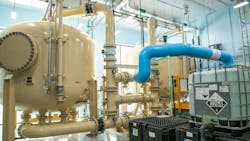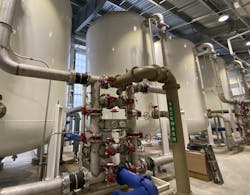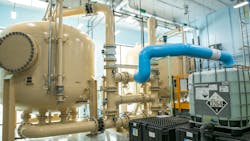In the United States, federal drinking water regulations are becoming increasingly concerned with per- and polyfluoroalkyl substances (PFAS).
With new regulations for PFAS on the horizon, there are currently a handful of main treatment processes for PFAS — but what does it look like to implement those processes? And, once PFAS has been removed from the water, what are utilities' options to affordably destroy the compounds known as "forever chemicals?"
Regulatory overview
The U.S. federal government is focused on PFAS regulation and is taking a broad approach, under several federal environmental laws, toward the development of national regulations. The federal government seeks a more consistent strategy to address PFAS than the patchwork of regulations by various state agencies that currently exists.
In June 2022, the U.S. EPA issued new Health Advisory (HA) levels for short-term exposure for various PFAS including, 0.004 parts per trillion (ppt) for perfluorooctanoic acid (PFOA), 0.02 ppt for perfluorooctane sulfonate (PFOS), 10 ppt for GenX chemicals, and 2,000 ppt for perfluorobutane sulfonic acid (PFBS). These HA levels were orders of magnitudes below any previous HA EPA levels proposed by EPA or any other state regulatory agency.
On March 14, 2023, EPA proposed the first enforceable National Drinking Water Standards for six PFAS including Maximum Contaminant Levels (MCLs) of 4.0 ppt, each for PFOA and PFOS, and a novel Hazard Index (HI) concept for perfluorononanoic acid (PFNA), PFBS, perfluorohexane sulfonate (PFHxS), and GenX in a mixture. EPA has indicated their intent to issue a final PFAS regulation in 2023 or 2024.
In parallel, the fifth Unregulated Contaminant Monitoring Rule (UCMR5) requires water agencies to monitor for 29 different PFAS compounds, so it is possible that the EPA will propose the regulation of additional PFAS. It is expected that large volumes of surface water and groundwater used to supply drinking water across the U.S. will require treatment to comply with the current proposed and potential future PFAS regulations.
To assist water systems in achieving compliance, the bipartisan Drinking Water and Wastewater Infrastructure Act of 2021 includes a comprehensive package that will invest billions of dollars in drinking water and wastewater infrastructure to address PFAS and other unregulated contaminants.
Implementing PFAS treatments
The best available technology (BAT) solutions to treat PFAS in water include granular activated carbon (GAC) adsorption, ion exchange (IX) resins, and nanofiltration (NF) or reverse osmosis (RO) membrane treatment processes.
Many water agencies have already begun to implement these PFAS treatment technologies in their processes.
Orange County Water District (OCWD) and their member agencies are currently installing IX systems to address PFAS that have been found in many groundwater wells within the Orange County Basin. On behalf of its member agencies, OCWD evaluated multiple PFAS treatment systems using bench-top and pilot studies. While IX and GAC were both effective, IX provided a smaller footprint and lower height and required fewer lead-lag pairs of vessels. OCWD also performed a life cycle cost analysis and concluded that IX had lower or similar life cycle cost as GAC. As such, OCWD’s member agencies selected IX as the PFAS treatment system for groundwater from the Orange County aquifer.
PFAS destruction technologies
While the treatment solutions are successful in removing PFAS from drinking water, they cannot break the PFAS cycle on their own. PFAS still accumulates in the spent GAC or IX resins, and in RO concentrate which effectively leaves residual wastes that must be handled and disposed of. To address these challenges, research and development programs are developing ingenious solutions, where innovators are evaluating emerging technologies to concentrate and then destroy PFAS without releasing harmful byproducts.
PFAS destruction technologies have recently been demonstrated successfully at bench-top. This includes, but is not limited to, hydrothermal alkaline treatment, photolysis, high-energy electron beam, and radiolytic. Destruction of PFAS has also been demonstrated successfully at the pilot-scale using electrochemical oxidation, plasma, supercritical water oxidation, UV-hydrated electron and sonochemical. The optimal destructive solution needs to consider the specific water quality, site constraints, disposal options and existing processes at each application.
A key component of any destructive technology is that the solution must not simply transfer the PFAS problem from one element of the environment to another (soil to air, water to wastewater, water to landfills, etc.). Identifying, developing, and implementing affordable destructive technologies that fully eliminate PFAS from the whole environment is therefore key to the health of our communities.
About the Author
Mark White
Mark White, PE, BCEE, is the global drinking water practice leader for CDM Smith and is based in Chicago, Illinois.
White is a board-certified environmental engineer with close to 30 years of international experience in the planning, design, and construction of water treatment facilities. He has evaluated and/or designed improvements to more than 40 water treatment plants totaling more than one-billion-gallons-per-day of capacity. He is well-versed in both conventional and advanced water treatment processes, including the treatment of PFAS and other compounds of emerging concern. He is an active contributor to various professional associations, including serving as both a trustee and a member of the Standards Council for the American Water Works Association.
Alan LeBlanc
Alan G. LeBlanc, PE, BCEE, is the drinking water treatment discipline leader at CDM Smith and is based in Manchester, NH.
LeBlanc is a civil engineer with 29 years of design and construction experience, including municipal water treatment, PFAS removal, application of sustainable design concepts, and construction cost estimating. His PFAS resume includes leading groundwater and surface water treatment studies, bench- and pilot-scale tests, designs, construction, and/or startup efforts for over 50 water supply facilities nationally. He served as chair of the New England Water Works Association Filtration Committee for eight years and has led training courses on filtration and granular activated carbon (GAC) adsorption design and operation for the past 18 years.


